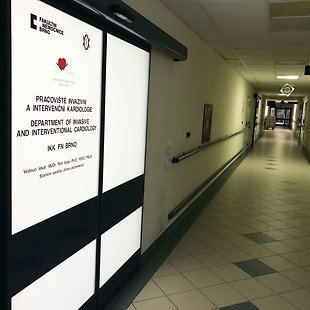Cardiac Pacing
Abnormal heart rhythms (arrhythmias, also dysrhythmias) are one of the most common heart diseases. According to heart rate they can be divided into two groups - bradycardias and tachycardias. The main cause of arrhythmias is a disorder in impulse formation and conduction in myocardial muscle. Generally, the presence of so-called arrhythmogenic substrate is the underlying cause of cardiac arrhythmias. This substrate can be a scar after myocardial infarction, source of ectopic automatism or degenerative changes of the myocardium.
Algorithm Cardiac Pacing provides insight into management of acute arrhythmias. It is also focused on perioperative treatment of sinus bradycardia that leads to cardiac asystole.
Review
This interactive algorithm describes very realistically a quite common situation, which can happen during operation to every anaesthesiologist. Bradycardias are always critical because anaesthesiologist has to make a right quick decision. Their etiology is important for prognosis of patients and for his next medical treatment. Vagal reaction on its irritation needs totally different approach than bradycardia caused by hypoxia or primary heart rhythm disorder. This model situation is using realistic information from monitors and tests results. A doctor solving this algorithm can do his own diagnosis and chose the right approach. The outcome of this algorithm is well created memory track with prompt recall in critical situation. Positive impact on patient is unambiguous. Great advantage of this interactive algorithm is its complexity. It shows not only operation complications but also therapy possibilities of this model hearth disease after stabilising the patient. Moreover, you will get to know typical ECG for used condition, induction to anaesthesia and transvenous cardiac pacing by interactive pictures and videos in this algorithm.
Sources
NOLAN, Jerry P., Jasmeet SOAR, David A. ZIDEMAN, Dominique BIARENT, Leo L. BOSSAERT, Charles DEAKIN, Rudolph W. KOSTER, Jonathan WYLLIE, Bernd BÖTTIGER a ERC GUIDELINES WRITING GROUP. European Resuscitation Council Guidelines for Resuscitation 2010 Section 1. Executive summary. Resuscitation [online]. 2010, 81(10), 1219–1276. ISSN 1873-1570. Retrieved from: doi:10.1016/j.resuscitation.2010.08.021
ČEŠKA, Richard, ŠTULC, Tomáš, Vladimír TESAŘ a Milan LUKÁŠ, ed. Interna. 2., In Prague: Stanislav Juhaňák - Triton, 2015. ISBN 978-80-7387-885-6.
JORDAN, J. L., I. YAMAGUCHI a W. J. MANDEL. Studies on the mechanism of sinus node dysfunction in the sick sinus syndrome. Circulation. 1978, 57(2), 217–223. ISSN 0009-7322.
ŠEVČÍK, Pavel a Martin MATĚJOVIČ, ed. Intenzivní medicína. 3., Prague: Galén, c2014. ISBN 978-80-7492-066-0.
Atropine - FDA prescribing information, side effects and uses. Drugs.com [online]. [vid. 2017-04-17]. Retrieved from: https://www.drugs.com/pro/atropine.html
Adrenalin Injection - FDA prescribing information, side effects and uses. Drugs.com [online]. [vid. 2017-04-17]. Retrieved from: https://www.drugs.com/pro/adrenalin-injection.html
TOPRAK, V., A. YENTUR a M. SAKARYA. Anaesthetic management of severe bradycardia during general anaesthesia using temporary cardiac pacing. British Journal of Anaesthesia. 2002, 89(4), 655–657. ISSN 0007-0912.





